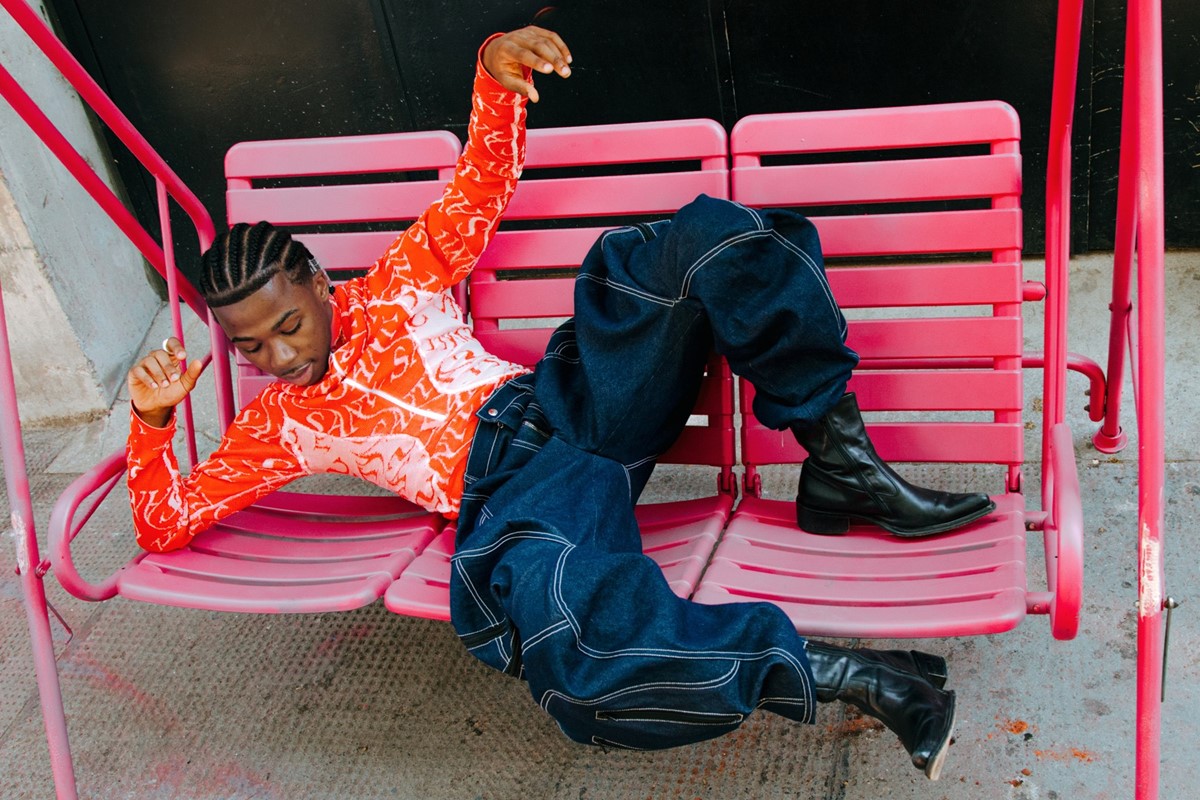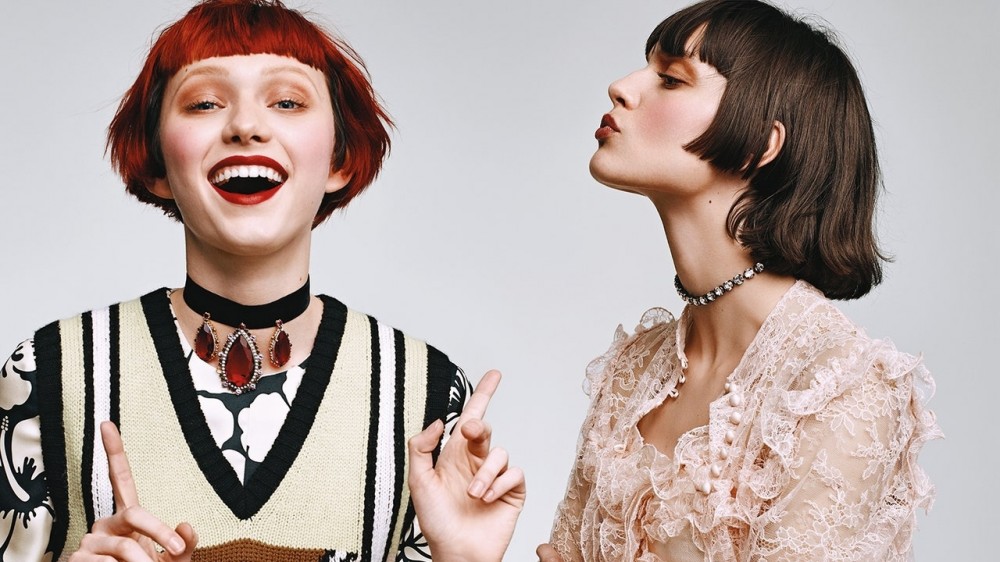
Introducing the 2021 fashion students taught by Grace Wales Bonner
As the British designer rounds off her first year of teaching at the University of Applied Arts in Vienna, we meet her debut cohort of designers – feat. witchy ceremonies, Bosnian petrol heads, and blood-splattered dresses
It was a little less than a year ago that Grace Wales Bonner was appointed head of fashion at the University of Applied Arts in Vienna. Yet, in the short time that has passed, the British designer’s unique approach to teaching is already legible in the collections of her modeklasse, the university’s prestigious fashion school. For these students, a new era has begun, and despite a longstanding history of celebrity lecturers – among them Karl Lagerfeld, Hussein Chalayan, Vivienne Westwood, and Raf Simons – this marks the first time that a young, Black woman has taken the reins.
Bonner’s work in fashion makes up just a small fraction of her multidisciplinary practice. It’s perhaps why she sees herself, as first and foremost, “a researcher” – although that research is always funnelled into “very different outcomes and outlets.” “It can be fashion design, creating a publication, or a film,” she says, speaking from her studio in London. “Research is the continuous element and fashion can be an expression of that.” This open-ended approach to fashion is drastically different when compared to the previous, siloed outlooks of previous guest professors – a breaking away from the traditional thinking of fashion’s status quo.




That means encouraging them to have a holistic way of creating. I hope to explore ways of presenting and to demonstrate the importance of having an authentic voice. They should be able to develop collections in a grounded way,” Bonner says. “In my education, cultural studies was part of the degree, and that was very valuable to me. So now it is very important for me to also include it in our curriculum. It is essential to understand the cultural context of your work.”
And as for the students? Well, they’ve seemingly fallen for their new tutor and all of the resources she makes available to them. First year student Delara Tavassoti, whose work is inspired by her Austrian-Iranian roots, sums it up nicely – “what we all value about Grace’s work is her deep understanding of the research behind her collections. We are eager to learn more from her knowledge.” When talking to the modeklasse students, it’s clear that Bonner wants to provide something else. An increasingly rare, and increasingly valuable commodity in our current culture: time. “With Grace, I have learned to be more precise and conscious, and this made me slow down,” Karoline Braegger, a third year student explains, sitting in the university’s light-flooded studio. “The increased space for research has definitely allowed me more room to approach projects in a more conceptual and considered way than before”, Johannes Hartmann, another third year, adds.
While Grace Wales Bonner may only be at the beginning of a three-year-long stint in Vienna, her debut cohort of students are taking their first steps into the outside world. We invited five of Bonner’s graduates to fill us in on their final collections, their favourite tutor, and the future of fashion.
ALESSANDRO SANTI

“My graduate collection represents a material reflection of sociological theories, and considerations on fashion and identity. The end result is the creation of an unusual wardrobe alienated from a gender-normative body, characterised by unexpected volumes, patterns, and proportions. The stereotypical wardrobe of tourists served as my inspiration. My personal history and experience as a tourist guide explains my interest and fascination, but the aim here is not to mock their outfits, nor is it to propose an improvement. Rather, it’s a comment on their gendered clothing, functional details, colour palettes, and peculiarities. In my design practice I always work in a genderless way. As a queer person myself, I have experienced several misconceptions related to my gender presentation, body and, altogether appearance. Those sometimes traumatic and always troubling events, pushed me to critically reflect on those norms, concepts, and to express them through my fashion.
During the pandemic I approached fashion in a calmer and more meditative way. I mainly worked digitally and gave myself time to reflect on what I was working on. I also used the time to dig deeper into theory. In the future, I see my brand, artistic, and design practice, at the intersection of many fields – with a big focus on communities and collaborations with other local creatives. I truly believe and hope that a slower, more sustainable, and ethical fashion system is possible. A system which is perhaps linked with local sourcing and networks, offering an alternative to the fast-paced expectations of mainstream fashion.”
@alessandro_snt
LARISSA FALK

“The exposure of the female body, and how unveiling the skin has historically changed in different cultures are the main topics of my thesis and diploma collection. In our society, women are pushed to constantly question their appearance through advertising, magazines, television, and social media. The starting point was my personal experience of growing up in the countryside bar my parents owned. It was frequented mainly by men. The women who worked there were exposed to their gaze on a daily basis. Because of this first-hand experience, I have always been critical of power structures and the ideas of feminine and masculine performativity.
Therefore, I wanted to explore shapes and create silhouettes that change the physical appearance of a wearer – creating a chance to explore different personas and self-perspectives. Revealing a human’s physique should not be a matter of age or gender but rather an awareness of why and for whom. I hope that in the future, small brands, collaborative studios, and independent designers will have a greater presence within the fashion industry. I would like them to receive the same attention which is given to big fashion houses. A collective slowing down would give designers more time and more resources. Fashion is made to produce as much as it can, but that does not give you a chance to reflect on the product.”
@_larissa.falk_
ILIJA MILICIC

“My project is called Samo Za Goste which means “guest only”. The collection is inspired by Balkan weddings, especially the ones I experienced in Bosnia as a child. The area I’m from is full of bikers and so the romantic idea of a wedding always had a certain roughness to it. I reinterpreted some classic garments and took inspiration from the tradition of decorating cars and covering them in tulle and flowers. I just enjoy seeing something as masculine as a car, looking more opulent and flamboyant than the bride. I’m very interested in the idea of masculinity and tend to look for its softer spots. Masculinity is typically a performance of strength, power and toughness. And what I try to create is this vision of soft masculinity and it works for me. It’s a broad topic that entails a lot of different conversations, so there’s definitely more than enough left for me to explore. I tend to look for soft spots in hard shells, so the idea of flamboyantly decorated cars felt very right.
Due to logistical issues caused by the pandemic I wasn’t able to push this idea as far as I wanted to. Just like some movies come with a “to be continued” after the credits roll, so does my collection. The pandemic taught me how to trust and to hand over some of my work to others. I had to put my ego to the side and come to terms with the fact that I’m not going to graduate with 15 looks. My focus had to shift from what I wanted, to what is reasonable under the given circumstances. For the future, I hope and believe that a change will come, but first we need to get rid of old habits and dated structures. It’s still a very exploitative industry and there is a dire need for the work conditions and pay to improve.”
@hvala_ilija
NIKOLA MARKOVIC

“My project is called To Be a Dragon. On a theoretical level, it applies Baudrillard’s idea of dismantling contemporary dress codes and their ‘simulation’ by withdrawing from ‘symbolic rituals’. Clothing is understood not through its economic or assigned values, but in its symbolism. So, I took a step back, exploring performance art from the late 20th century and Badrillard’s ‘models of symbolic exchange’ within indigenous structures. I looked at the events of 2020, aiming to resolve personal intergenerational trauma and to reconnect to my heritage. The clothes in this context serve as a bridge. The pandemic made me live with my family for quite a while, and it was intertwined with many calamitous events, which were all fueling my collection on an emotional level.
Furthermore, the pandemic changed our perception of time and offered new rituals for everyday life. I wanted to capture this shift. For instance, I pricked my fingers every day for three months and left the blood drops on a replica of my mother’s polka dot slip-dress – the one she was found in when she attempted suicide in September. Somehow the pandemic was more about real garments than the fantasy that the fashion system is trying to sell. Fashion will always be obsessed with the future, and all the novelty that comes with it, but at the same time it always references the past. This paradox showcases how irrelevant time is. Things change on a surface level following cultural shifts, but the matrix of fashion and its position in broader cultural experience stays the same.”
@niko__markovic
CODY KLIPPEL

“This collection idolises a strong single mum who performs Wiccan ceremonies in her backyard and runs with a pack of like-minded witches and earth worshippers, regardless of race, gender or sexuality. It was inspired by the memory of one of the mums at my elementary school in Portland, Oregon, where I grew up. I was fascinated by this woman as a child, and I used this memory to imagine her life on the farm, reworking and beautifying the clothing that she would wear for beekeeping and tending to her garden. She elevates the mundane and assigns ritualistic meaning to her daily tasks, and I used the same mindset in readapting and enhancing dead stock, finding materials to give her a wardrobe worthy of her island ceremonies.
I fell really deep into this woman’s story and the development of this collection in a way that would have been difficult if I hadn’t been so isolated. I can imagine her up late, crafting and sewing alone in just the same way that I was, and in hindsight, it’s special that I was able to live her story to that extent. The pandemic confirmed my love for the tactile and deepened my fascination for garment making. And while it’s fun to see how fashion can be filmed, 3D-scanned, and marketed digitally, nothing comes close to the experience of touching, wearing, and viewing beautifully made clothing in person. I hope we can collectively learn to cherish and care for our clothes more – not just because so much time and so many resources go into making them, but really because they’re highly evolved and incredibly sharp cultural documents that tell our stories, express our values, and accompany us through all of life.”
@codyklippel



